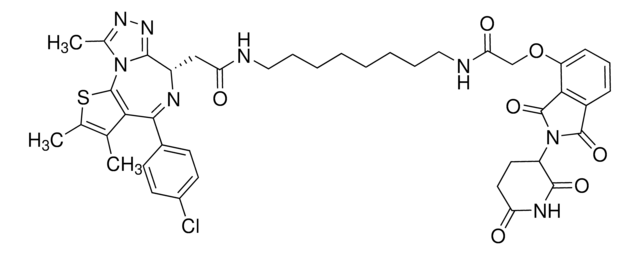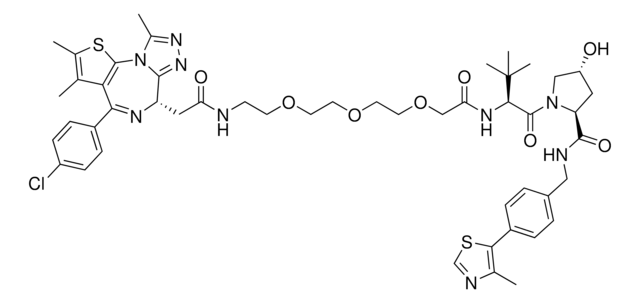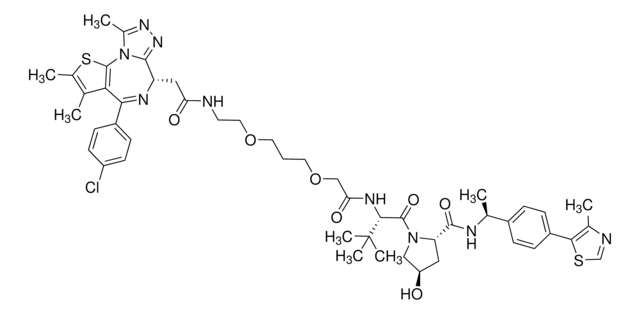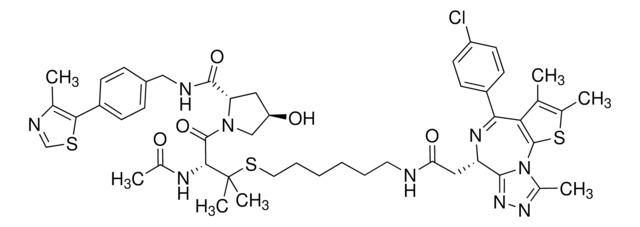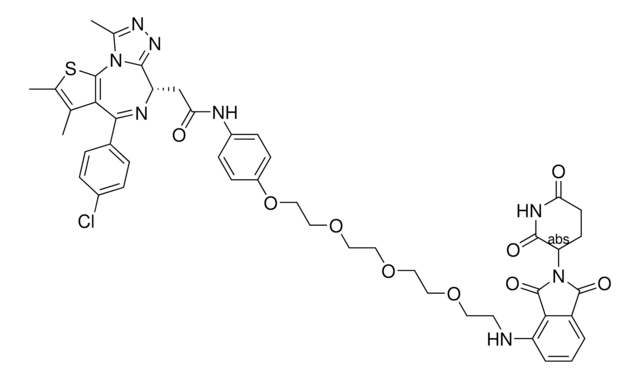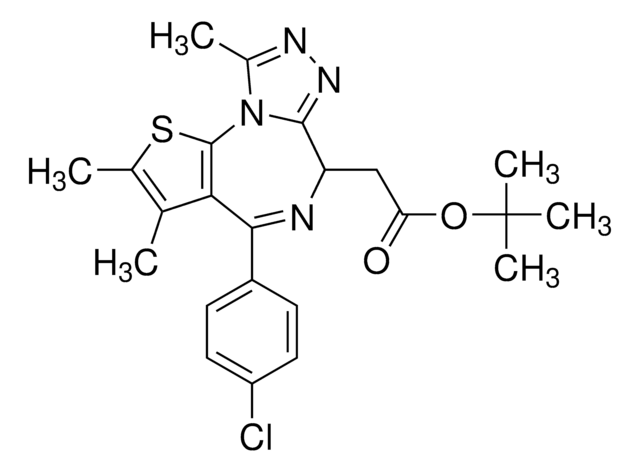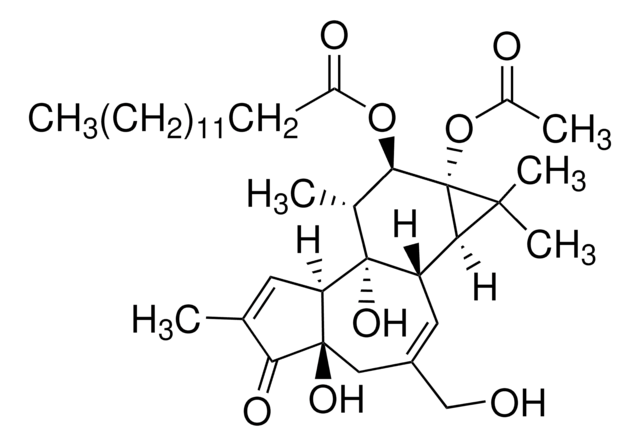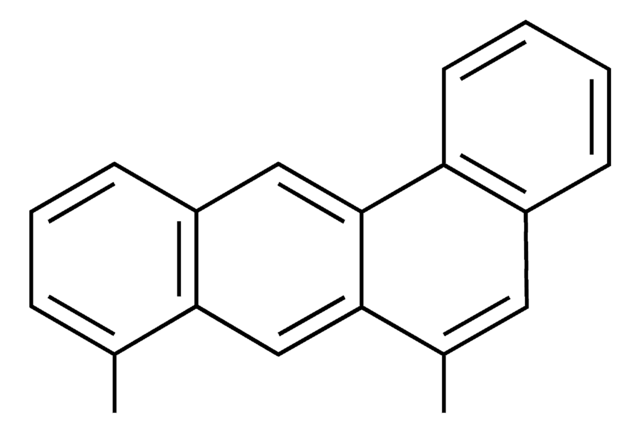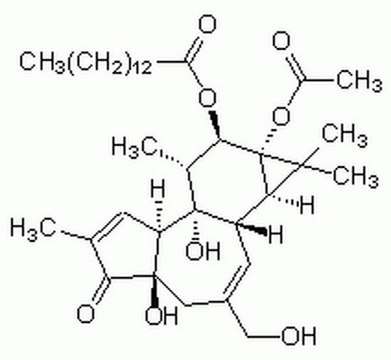SML2687
dBET1
≥98% (HPLC)
别名:
(6S)-4-(4-Chlorophenyl)-N-[4-[[2-[[2-(2,6-dioxo-3-piperidinyl)-2,3-dihydro-1,3-dioxo-1H-isoindol-4-yl]oxy]acetyl]amino]butyl]-2,3,9-trimethyl-6H-thieno[3,2-f][1,2,4]triazolo[4,3-a][1,4]diazepine-6-acetamide, 2-((S)-4-(4-Chlorophenyl)-2,3,9-trimethyl-6H-thieno[3,2-f][1,2,4]triazolo[4,3-a][1,4]diazepin-6-yl)-N-(4-(2-(2-(2,6-dioxopiperidin-3-yl)-1,3-dioxoisoindolin-4-yloxy)acetamido)butyl)acetamide
登录查看公司和协议定价
所有图片(1)
About This Item
推荐产品
ligand
thalidomide
方案
≥98% (HPLC)
表单
powder
颜色
white to beige
溶解性
DMSO: 2 mg/mL, clear
储存温度
−20°C
SMILES字符串
[s]1c2c(c(c1C)C)C(=N[C@H](c7[n]2c(nn7)C)CC(=O)NCCCCNC(=O)COc4c5c(ccc4)C(=O)N(C5=O)C6CCC(=O)NC6=O)c3ccc(cc3)Cl
InChI key
LKEGXJXRNBALBV-PMCHYTPCSA-N
生化/生理作用
A JQ1-and-phthalimide conjugate that causes the degradation of BRD4 protein
dBET1 is a JQ1-and-phthalimide conjugate that causes the degradation of BRD4 protein, a transcriptional coactivator that regulates the expression of genes that promote cancer cell proliferation and survival. JQ1 is a selective BET bromodomain (BRD) inihbitor. The phthalimide portion is a derivative of the drug thalidomide, which is known to bind to cereblon (CRBN), part of an ubiquitin E3 ligase complex resulting in ubiquitylation and degradation by the proteasome. The conjugate dBET1 induced highly selective cereblon-dependent BET protein degradation both in vitro and in vivo. It induced complete CRBN-dependent proteosomal degradation of BRD4 in a human acute myeloid leukaemia (AML) cell line and delayed leukemia progression in mice.
相关产品
产品编号
说明
价格
储存分类代码
11 - Combustible Solids
WGK
WGK 3
闪点(°F)
Not applicable
闪点(°C)
Not applicable
法规信息
新产品
历史批次信息供参考:
分析证书(COA)
Lot/Batch Number
Afua A Akuffo et al.
The Journal of biological chemistry, 293(16), 6187-6200 (2018-02-17)
Upon binding to thalidomide and other immunomodulatory drugs, the E3 ligase substrate receptor cereblon (CRBN) promotes proteosomal destruction by engaging the DDB1-CUL4A-Roc1-RBX1 E3 ubiquitin ligase in human cells but not in mouse cells, suggesting that sequence variations in CRBN may
Georg E Winter et al.
Science (New York, N.Y.), 348(6241), 1376-1381 (2015-05-23)
The development of effective pharmacological inhibitors of multidomain scaffold proteins, notably transcription factors, is a particularly challenging problem. In part, this is because many small-molecule antagonists disrupt the activity of only one domain in the target protein. We devised a
Kelly M DeMars et al.
Neurochemistry international, 127, 94-102 (2019-03-16)
Neuroinflammation after stroke significantly contributes to neuronal cell death. Bromodomain and Extra Terminal Domain (BET) proteins are essential to inflammatory gene transcription. BET proteins (BRD2, BRD3, BRD4, and BRDT) have varied effects including chromatin remodeling, histone acetyltransferase activity, and as
我们的科学家团队拥有各种研究领域经验,包括生命科学、材料科学、化学合成、色谱、分析及许多其他领域.
联系技术服务部门